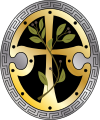This article needs additional citations for verification. (March 2024) |
The Hellenic Gendarmerie (Greek: Ελληνική Χωροφυλακή, Elliniki Chorofylaki) was the national gendarmerie and military police (until 1951) force of Greece.
| Hellenic Gendarmerie Ελληνική Χωροφυλακή | |
|---|---|
 Emblem of Hellenic Gendarmerie, 1969–1984 | |
 War flag of the Hellenic Gendarmerie, 1951–1984 | |
| Agency overview | |
| Formed | 1833 |
| Dissolved | 1984 |
| Superseding agency | Hellenic Police |
| Jurisdictional structure | |
| Operations jurisdiction | Greece |
| General nature | |
| Operational structure | |
| Parent agency | Ministry of Public Order |
| Notables | |
| Person |
|
| Anniversaries |
|
History
edit19th century
editThe Greek Gendarmerie was established after the enthronement of King Otto in 1833 as the Royal Gendarmerie (Greek: Βασιλική Χωροφυλακή) and modeled after the French National Gendarmerie. It was at that time formally part of the army and under the authority of the Army Ministry. Several foreign advisers (particularly from Bavaria, who emphasized elements of centralization and authoritarianism), were also brought in to provide training and tactical advice to the newly formed force. The main task of the Gendarmerie under the army as a whole during this period was firstly to combat the extensive banditry which was endemic in the countryside throughout the 19th century and included kidnappings for ransom, the suppression of local revolts, and the establishment of a strong executive government. Dimitrios Deligeorgis was appointed commander in 1854.
The army's links to the Gendarmerie and the nature of the structure of the force and its hierarchy (that of being similar to the army) was maintained throughout the 19th century for a number of reasons, primarily the socio-political unrest that characterized the period including disproportionate poverty, governmental oppression, sporadic rebellions and political instability. As a result of this, as well as the input of the armed forces, the Gendarmerie remained a largely conservative body throughout the period, there was also a certain amount of politicization during training as the Gendarmerie were trained in military camps.
20th century
editIn 1906 the Gendarmerie underwent its first major restructuring at an administrative level. It acquired its own educational and training facilities independent of those of the army (though still remaining a nominal part of the armed forces). Despite this the Gendarmerie still maintained a largely military based structure, based on its involvement in the Macedonian Struggle, and the Balkan and First World Wars. As a result, it tended to neglect civilian matters, something addressed with the establishment of a civilian city police force for Attica in 1920, which would eventually be expanded to urban centers in the entire country.
Modernization of the country's police forces was stunted by the successive periods of political instability, which culminated in the regime of Ioannis Metaxas and the Second World War. After the war, however, British experts were brought in to help reform the police along the lines of the British Police. As a result, after 1946 the police forces ceased to be a formal part of the Defence Ministry, although they retained several military features and were organized along military lines.
Reflecting a new emphasis on civilian policing, in 1984 both the Gendarmerie and the Cities Police were merged into a single unified Hellenic Police.[1] Although elements of the former military structure and hierarchy were maintained, explicit characteristics of a "militarily organized" force (such as courts-martial) were lost.
Ranks insignia
edit1908–1935
edit| Ranks | |||||
|---|---|---|---|---|---|
| Moirarchos | Ypomoirarchos | Anthypomoirarchos | Enomotarchis A' | Enomotarchis Β' | Ypenomotarchis |
1935–1970
edit| Ranks | |||||||||||||||
|---|---|---|---|---|---|---|---|---|---|---|---|---|---|---|---|
| Lieutenant General (Chief) Αντιστράτηγος | Major General (Υποστράτηγος) | Brigadier Ταξίαρχος
(1946 onwards) |
Colonel (Police director) Συνταγματάρχης | Lieutenant Colonel Αν/χης | Major (Ταγματάρχης) | Commander Μοίραρχος | Lieutenant Υπομοίραρχος | Second Lieutenant Ανθυπομοίραρχος | Warrant Officer Ανθυπασπιστής | Gendarme Master Sergeant Ενωμοτάρχης Α΄ | Gendarme Staff Sergeant Ενωμοτάρχης | Gendarme Sergeant Υπενωμοτάρχης | Gendarme Χωροφύλακας | Gendarme Operative Δόκιμος Χωροφύλακας | |
1975–1984
editEquipment
editSmall arms
edit| Name[2] | Country of origin | Type | Notes | Image |
|---|---|---|---|---|
| Smith and Wesson № 38 | United States | Revolver | Length: 26 cm
Weight: 801 gr |
|
| № 36 grenade | United Kingdom | Hand grenade | ||
| MK3A1 grenade | United States | Hand grenade | ||
| CN M7 tear gas grenade | ||||
| CN DM irritant grenade | ||||
| AN-M14 incendiary grenade | ||||
| CH (M8) smoke grenade | ||||
| M15 white phosphorus smoke grenade | ||||
| M18 colored smoke flare | ||||
| AN-M3 red smoke flare [1] | ||||
| Lee–Enfield | United Kingdom (№ 1,3,4)
Canada (№4) |
Bolt action rifle | ||
| M1 Garand | United States | Semi-automatic rifle | ||
| Thompson | United States | Submachine gun | ||
| Bren gun | United Kingdom | Light machine gun | ||
| 60mm M19 mortar | United States | Mortar |
References
editThis article includes a list of general references, but it lacks sufficient corresponding inline citations. (April 2017) |
- After the War was Over, Mark Mazower (Reconstructing the family, nation and state in Greece)